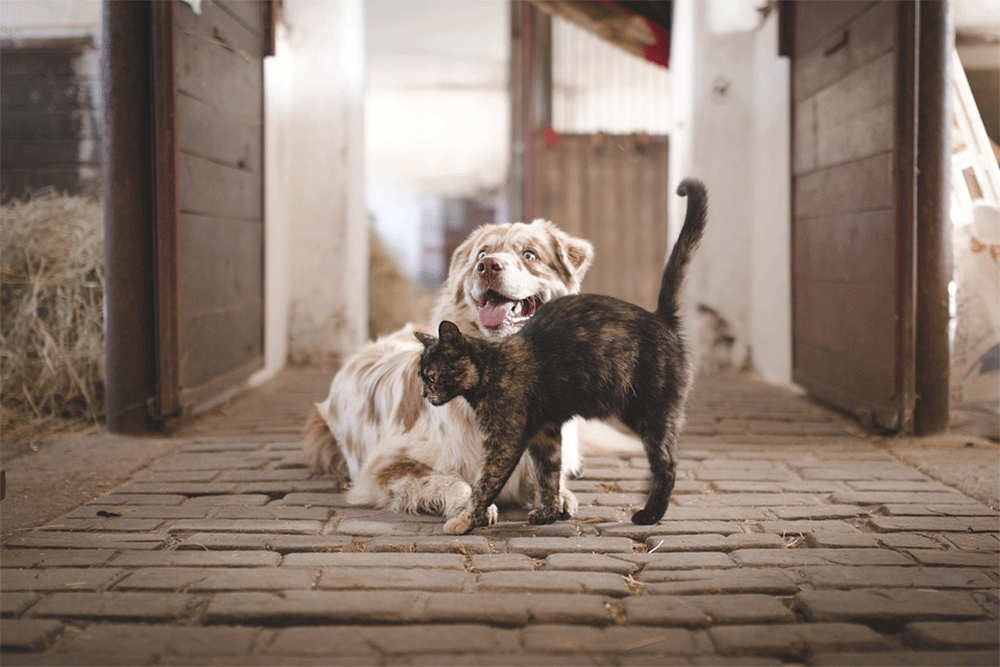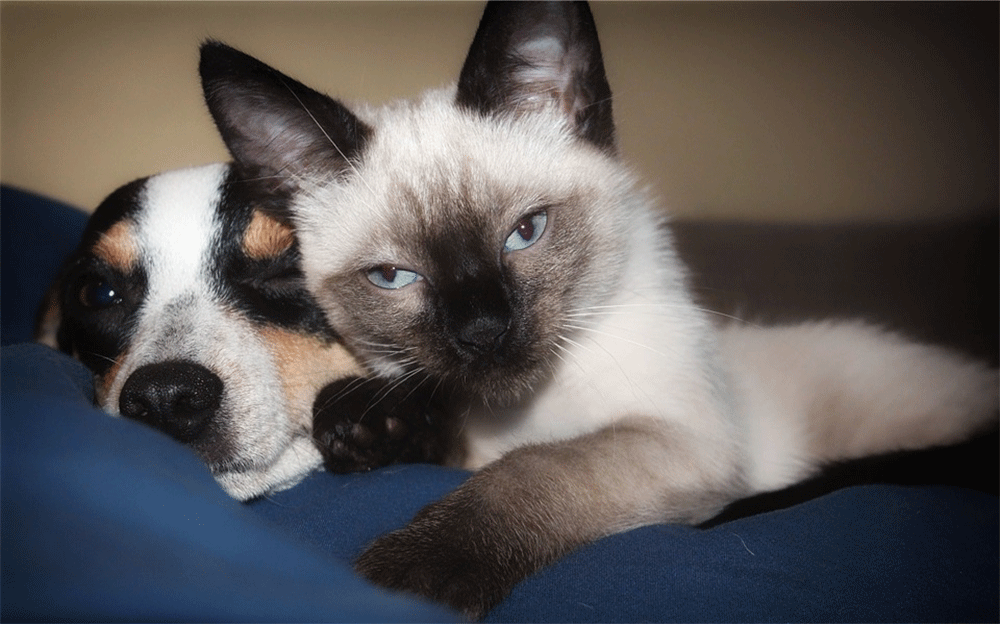It’s a known fact: cats and dogs have been enemies since the dawn of time. However, some of us know cats and dogs do get along and find that our pets live in harmony. Until one day, seemingly out of nowhere, our cat attacks the dog.
It leaves us wondering, why has this happened? How do we stop it? These questions can plague us and keep us up at night, wondering why our cats have seemingly turned against each other for no reason.
But we are here to put those worries to bed once and for all! We will look at why your cat could be attacking your dog and how we can stop that behavior! Keep reading for all you ever need to know.

Why is my cat attacking my dog?
There are many reasons why your cat has started attacking your dog, such as feeling territorial, feeling threatened, or they might even have an underlying medical issue!
More often than not, your cat’s aggression isn’t related to your dog! Although this isn’t always comforting, there are plenty of solutions to your cat’s aggression that can return your home to a peaceful paradise for your pets. To help you diagnose your cat’s aggression and offer you solutions to fix their aggression.
Keep on reading for the main causes and fixes for your cat’s aggression!
Is it over status?
Cats, like the lions they descend from, are known as the King of the Jungle and tend to rule the roost. Your cat can often want to assert their status and be seen as in control of the house. Often, they can perceive dogs or other animals as a threat to their control and status and respond with aggression.
This fight for status is commonly seen in homes with multiple pets and can be caused if they see you paying the dog more attention, for example. This aggression can also be seen in their tendency to block doors and anger at being moved. Ensure that you are paying your cat equal attention to avoid these status fights.
Is it all about territory?
On the same page as status is territorial aggression. Cats can see your house or garden as their territory and view the dog or other pets as intruders on their territory. This intrusion will lead them to attack suddenly, defending their ‘patch.’
We can link this territorial behavior back to their instincts which stem from their bigger and wilder cousins. We often see territorial aggression when dogs are recently introduced into the home. Your cat can perceive this new pet as a threat and attack.
They can also feel insecure about territory when renovations, moving, or new cats enter the street. All of these situations can impact your cat’s behavior, and they will often take it out on the dog or other pets in the home.
Is it redirected aggression?
Another reason why your cat has attacked your dog could be redirected aggression. We touched on this briefly earlier, but let’s look at it in closer detail now. External stimuli such as other animals, noise, or smell can wind your cat up and build their aggression levels.
When your dog crosses their path, although it might not be doing anything, your cat can lash out and unleash its anger on the dog. In these instances, it’s a case of wrong place, wrong time, and apart from keeping your cat as calm as possible at home, there is little you can do to prevent redirected aggression.
If you know there will be disturbances that will distress your cat, such as building work, it might be worth keeping the cat and dog separate to avoid any unprovoked attacks.
Could it be fear?
Fear is another reason your cat can be lashing out and attacking your dog. Even if you can’t see the treat, or the cat perceives it, it can cause them to attack the dog, as though they are protecting themselves from a situation they cannot escape.
You don’t need us to tell you that cats are quite skittish animals and can feel threatened easily. If you have a quite energetic dog that tends to roughhouse with your cat, it’s easy to see how fear and intimidation can spring from this!
What about medical conditions?
An underlying medical condition is a serious reason causing your cats aggression to your dog and will need to be treated accordingly. Conditions that cause pain, such as a recent operation, arthritis, or an infection, can cause even the calmest of cats to lash out in anger.
Think about when you are sick; often, the last thing you want is someone sniffing you and hassling you to play! It can be a good idea to keep your pets separate while one recovers from an illness to avoid causing them any further distress or anger.
Aggression in your cat could also be a sign of a neurological condition or cognitive decline. These can cause random bursts of aggression to your dog and can be potentially serious conditions. If you are concerned that this could be the reason for your cat’s aggression, contact your vet immediately.
What are the signs my cat is about to attack my dog?

Now that we have covered why your cat could be displaying aggression to your dog, let’s look at some of the signs before they attack so you can be better prepared for the situation and even prevent it in some cases.
Typically, your cat will show one or a few of the following traits before attacking your dog:
- Clawing
- Biting
- Scratching
- Growling
- Spitting hissing
If your cat is exhibiting any of these behaviors towards your dog, you must separate them immediately to prevent any injury or harm. Often it will be easier to remove your dog from the situation; after all, who wants a cat claw to the eye?
Unfortunately, we don’t always get much warning, and you shouldn’t need to sport them often. As much as we might moan about it, cat aggression towards dogs isn’t actually that common.
Another good indication of your cat’s aggression is its posture. When your cat is about to attack your dog, they can show two different postures: defensive and offensive. Let’s take a closer look at these to help you identify these postures and a cat about to attack!
Defensive?
A defensive posture is usually seen when your cat attempts to make themselves look smaller. They do this to try and protect themselves from a perceived threat. Flattened ears, their tail tucked under their body, and a crouched position are all signs of a defensive posture. Raised hackles are also another sign of a defensive posture, where the hair on the back of your cat will stand up.
In the defensive position, your cat will try and turn away from the perceived threat, hit it, or swat at it. This posture is commonly associated with a fear-based behavioral issue. It can be resolved with the help of your vet or a behavioral specialist if you are concerned about the behavior.
Generally, we would recommend consulting a vet if this behavior is exhibited frequently. There can sometimes be patterns that emerge, and you can adjust your behavior or the running of your home to accommodate your cat’s needs.
Offensive?
The second type of posture is offensive, where your cat is positioning itself to look intimidating. You will be able to recognize this by the raised ears, still tail, legs, and raised hackles. Your cat might also stare at its target (your dog) and growl or howl at them.
A combination of, or just one of these traits, is a sign that your cat is about to attack. Often these will be seen just before your cat suddenly attacks your poor dog, seemingly out of nowhere!
It’s essential to act quickly if you see these signs; moving your dog is probably the easiest way to separate the animals. As your cat is already angry and ready to attack, its claws and teeth can cause a lot of damage to you or your dog!
Offensive behavior is often considered more aggressive than defensive behavior. You should seek help from your vet or a behavioral therapist to ensure you can get to the bottom of your cat’s behavior and rectify it where possible.
When should I ask for help?
Sometimes all can feel hopeless, and you stand in your lounge, helpless, desperately trying to stop your cat from attacking your dog. It’s at this point you should seek help from your vet or a behavioral specialist.
If your cat’s aggression towards your dog is becoming more and more frequent, we recommend consulting your vet to rule out any underlying medical issues. They can often help diagnose the behavioral concerns or recommend a specialist who can conduct home visits to understand the situation better.
Asking for help is a personal choice, and when to ask depends on your situation and how often your cat attacks your dog. If you have recently introduced your dog to the house, we would give it a few weeks, maybe a month, for the cat to settle down before seeking help.
As we have said, this depends from situation to situation. There is no time frame here and if you feel you need help, then ask for it.
Final Thoughts
And just like that, we have reached the end of our time together today! As you can see, there are lots of reasons why your cat can suddenly attack your dog for no apparent reason. Understanding these reasons can help you make your home a calmer and safer environment for your pets to exist in peace.
Cats are unpredictable creatures; after all, they are semi-wild, and predicting their actions can be tricky! But understanding where the aggression comes from and the warning signs of an attack can help prevent these attacks and save your dog from another bout of cat-based aggression.
Just before you leave, it’s worth noting that these points are just generalizations. Each and every cat and home setup is different, meaning your pets will all interact and behave differently. To ensure you are meeting their needs appropriately, you might need to enlist the help of your vet or an animal behavioral therapist.
We recommend looking for help where necessary or if you are concerned that your cat’s aggression could be a sign of any neurological or medical conditions. Diagnosing and understanding your cat and its aggression will help you create a peaceful home in the long term!
